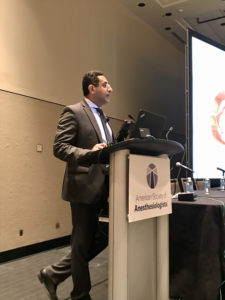Death and permanent brain damage still occur in a number of patients with extubation failure. That’s the word from the ASA Closed Claims Project Database and the focus of Monday’s session “Extubation of the Difficult Airway with a Focus on Patient Outcomes.”

Maged Argalious, M.D., M.Sc., M.B.A., M.Ed., FASE, FASA
The session was designed to highlight safe airway management strategies and also provided an organized, stepwise approach toward management of extubation failure, with a focus on improving patient outcomes and reducing extubation failure related to major morbidity. Maged Argalious, M.D., M.Sc., M.B.A., M.Ed., FASE, FASA, an Anesthesiologist at the Cleveland Clinic, led the discussion.
“Data from the ASA Closed Claims Project Database show that 17% of brain injuries and deaths occur after extubation in the O.R. or post-anesthesia care unit,” said Dr. Argalious.
Adding to that, Dr. Argalious said the Closed Claims data might not be catching all of the extubation failures.
“Not all cases of severe airway-related injuries result in a claim,” he said. “In addition, it takes years between the date of an injury to the entry of a claim into the database.”
While we may not know the exact degree of injuries and death resulting from extubation failures, following safe airway extubation strategies can lessen a patient’s odds of becoming a statistic. Dr. Argalious encouraged attendees to formulate a stepwise approach for safe extubation. For this, he provided guidelines:
- Adhere to evidence-based extubation criteria – general, mechanical and chemical.
- Optimize medical management up front in terms of preoxygenation, positioning the patient and medicating the patient to minimize the activation of airway refluxes and reduce laryngeal edema and post-extubation stridor.
- Consider any risk factors for extubation failure, including pre-existing airway difficulties, perioperative airway deterioration and restricted airway access.
- Consider awake versus deep extubation based on the level of difficulty of the airway, the aspiration risk, an altered baseline level of consciousness and whether the patient has a high BMI.
- Have a preformulated plan in case of extubation failure and ensure that you will have quick access to all required equipment and medications.
- In select surgeries, you may consider routine fiberoptic evaluation prior to extubation.
Dr. Argalious also urged attendees to know how to correctly perform and interpret a cuff leak test, noting that patients with positive cuff leak tests (with a cuff leak volume of less than 110 ml or less than 15% VTI) are more likely to develop post-extubation stridor than patients with negative cuff leak tests (with a cuff leak volume of 110 ml or higher and a VTI of greater than 15%). A negative cuff leak test can avoid unnecessary delays provided that other extubation criteria are met, while a positive cuff leak test identifies patients who are at risk and may require the use of steroids to reduce laryngeal edema.
Dr. Argalious highlighted the correct way to use air exchange catheters (AECs) with inner hollow lumens to allow oxygen insufflation. The AEC should have an outer diameter smaller than the inner diameter of the ETT to be replaced, and the markings should be matched with the centimeter markings on the ETT to avoid excessive advancement.
If you encounter resistance during the advancement of the ETT over the AEC, Dr. Argalious suggested video-laryngoscopy to aid the tube advancement, an anticlockwise rotation of the ETT in 90-degree increments, and/or the use of ETTs with flexible tips.
Should you encounter an extubation failure, Dr. Argalious said it’s important to organize the steps required for management. He highlighted two special situations – an expanding neck hematoma and a cervical spine surgery – noting that these are both instances in which steps should be clearly laid out in advance. For example, when managing a postoperative neck hematoma, it’s crucial to apply pressure to the bleeding site, notify the surgical team, consider a reversal of residual anticoagulation, tighten blood pressure control and mark the site of the cricothyroid membrane.
Dr. Argalious called for more collected data, both locally and nationally, on patterns of airway injury to update algorithms and for anesthesiologists to share their best practice with their peers.
“The most successful institutions have protocols to manage these patients,” he said.
Return to Archive Index